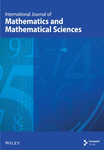Series and Rational Solutions of the Second Kind Painlevé Equations by Using the Quantum Pseudospectral Method
Abstract
The Painlevé equations and their series and rational solutions are essential in applied, pure mathematics and theoretical physics. Recently, quantum algorithms have helped to implement numerical algorithms more easily by performing linear algebra in our working. This article uses a hybrid of quantum computing schemes and spectral methods for the second Painlevé equation. Two approaches are investigated: first, a series solution is obtained, and then the rational solutions. The successive linearization method is used for the linearization of the Painlevé-II equation. In the computer implementation, the solution value of the Painlevé-II equation is considered as a final quantum state. In each iterative scheme, by adding the current quantum state, we can compute the final quantum state. We need different quantum models for each approach, series, and rational solutions. Numerical examples illustrate the efficiency of this method, and reasonable solutions are obtained for a wide range of parameter values.
1. Introduction
Spectral methods have an important role in solving engineering problems such as differential equations, with efficient and accurate numerical solutions (see [11, 12]) and many other books in this topic. By the combination of spectral methods and a mesh-free approach, many problems can be solved [13, 14]. Very recently, Taema and Youssri have developed a spectral collocation method by using third-kind Chebyshev polynomials to solve a system of two nonlinear integrodifferential equations that arise in biological modeling [15]. Youssri and Atta have proposed a novel spectral algorithm utilizing Fibonacci polynomials to numerically solve both linear and nonlinear integrodifferential equations with fractional-order derivatives [16].
In this article, a quantum pseudospectral method (QPSM) for the nonlinear second kind Painlevé equation (1) is considered; very recently, this method has been used for solving the general Lane–Emden type equations [17]. The author believes that it is the first attempt to find the series and rational solution for the Painlevé-II equation with the quantum pseudo-spectral method. Two approaches are studied. In the first attempt, the governing equation (2) for t ∈ [0, 1] with the initial conditions (2) is considered. In the second attempt, the rational solutions of the second kind Painlevé equation are considered. The QPSM by using the quantum linear system algorithm (QLSA) [18] is designed for linear initial value problems (IVP) [19]. The quantum algorithm in [19] is based on a pseudo-spectral method for time-dependent IVP with the polynomial complexity.
2. QPSM
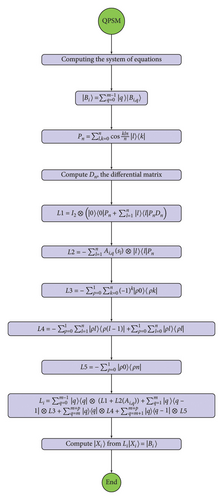
In continuation, the total error in this method is explained. A part of the error is due to the linearization of equation (5). Remarks 1 and 3 explain this. Another part of the error is related to the pseudo-spectral method (see Lemma 1).
Remark 1. The error generated in (7) is due to
3. Results and Discussion
Some examples with different α in (2) for showing accuracy and comparing with other methods are considered. In all examples, we put p = 1, and Python 3.12.4 is used for programming. Algorithm 1 shows the description of this method.
In the first attempt, we consider α = 1 in the second Painlevé equation (2). Figure 2(a) shows results of the QPSM for n = m = 20 with M = 5, and the right figure shows the relative absolute error of the QPSM concerning the Runge–Kutta method (RKM) [24] with atol = 0.00000001 (absolute tolerances). Table 1 shows a comparison between the QPSM, the RKM, the Sinc-collocation method [8], the VIM [25], the OHAM [9], the VAP [10], and the Legendre τ-decomposition method (LTM) [6].
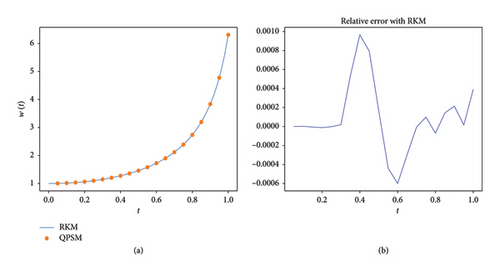
| t | QPSM | RKM | Sinc | VIM | OHAM | VAP | LTM |
|---|---|---|---|---|---|---|---|
| 0.1 | 1.01524354 | 1.01524596 | 1.015243802 | 1.015243537 | 1.01697332 | 1.015 | 1.01525769 |
| 0.2 | 1.06261465 | 1.06260244 | 1.062615730 | 1.062614651 | 1.06804971 | 1.063 | 1.06259868 |
| 0.3 | 1.14637603 | 1.14639773 | 1.146377520 | 1.146376034 | 1.15463133 | 1.146 | 1.14638761 |
| 0.4 | 1.27415229 | 1.27538325 | 1.274150163 | 1.274152278 | 1.28209418 | 1.275 | 1.27413995 |
| 0.5 | 1.45921345 | 1.45945595 | 1.459216534 | 1.459213319 | 1.46396018 | 1.468 | 1.45923019 |
| 0.6 | 1.72537555 | 1.72434098 | 1.725383228 | 1.725374098 | 1.72697690 | 1.743 | 1.72535520 |
| 0.7 | 2.11844345 | 2.11843013 | 2.118441811 | 2.118431139 | 2.11915382 | 2.156 | 2.11846104 |
| 0.8 | 2.73693513 | 2.73674274 | 2.736942571 | 2.736846427 | 2.73683163 | 2.806 | 2.73693516 |
| 0.9 | 3.84437392 | 3.83519858 | 3.834408328 | 3.833780746 | 3.83251635 | 3.934 | 3.83437316 |
| 1.0 | 6.30892109 | 6.31139164 | — | — | — | 6.259 | — |
-
Algorithm 1: QPSM algorithm for finding the series solution of the Painlevé-II equation.
-
Input:M = 5, n = m = 20, p = 1 and initial approximation w0(t) = (α/2)t2 + 1.
-
Output:w(1)
- 1.
y = yInitial = w0(1)
- 2.
fori⟵1 to Mdo
- 3.
Compute L1, L2, L3, L4, L5 in Section 2 // for computing Li in (24)
- 4.
Compute Bi, right-hand side of (24)
- 5.
Compute , the solution of (24)
- 6.
Extract xi0 from Xi // (2m(n + 1) + 1)th vector component
- 7.
y⟵y + xi0
- 8.
returny
Figure 3(a) shows results of the QPSM for α = 2 and n = m = 20 with M = 5, and the right figure shows the relative absolute error of the QPSM concerning the RKM [24] with atol = 0.00000001 (absolute tolerances). Table 2 shows a comparison between the QPSM, the RKM, Adomian’s decomposition method (ADM) [7], theLTM [6], the Sinc-collocation method, and VIM coupled with Padé approximation (VIPA) [8]. Figure 4 show the residual error in first partition for M = 5 and n = m = 20. The results show the efficiency of the QPSM.
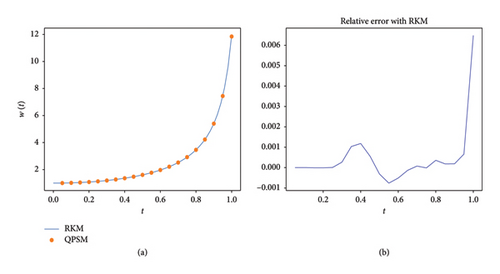
| t | QPSM | RKM | ADM | LTM | Sinc | VIPA |
|---|---|---|---|---|---|---|
| 0.1 | 1.02026919 | 1.02027074 | 1.020269194 | 1.021047331 | 1.020269516 | 1.020269194 |
| 0.2 | 1.08304976 | 1.08303857 | 1.083049760 | 1.082116225 | 1.083050684 | 1.083049760 |
| 0.3 | 1.19379025 | 1.19410929 | 1.193790245 | 1.194531584 | 1.193791418 | 1.193790245 |
| 0.4 | 1.36282365 | 1.36443616 | 1.362823651 | 1.361992274 | 1.362825244 | 1.362823638 |
| 0.5 | 1.60929104 | 1.60878420 | 1.609291039 | 1.610416473 | 1.609294013 | 1.609290816 |
| 0.6 | 1.97019075 | 1.96918366 | 1.970190748 | 1.968817717 | 1.970195495 | 1.970188429 |
| 0.7 | 2.52374240 | 2.52393387 | 2.523742462 | 2.525021861 | 2.523748780 | 2.523724908 |
| 0.8 | 3.46221940 | 3.46346053 | 3.462223434 | 3.461891692 | 3.462235205 | 3.462114640 |
| 0.9 | 5.40216795 | 5.40317736 | 5.402303840 | 5.400956596 | 5.402575104 | 5.401914998 |
| 1.0 | 11.84754955 | 11.92435805 | — | — | — | — |
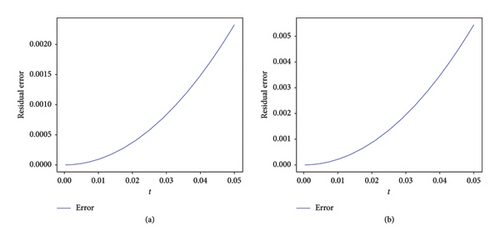
4. Approximating the Rational Solutions
As we said before, the second Painlevé equation (2) has many interesting properties such as the Painlevé property, which means that the only moveable singularities are poles [1], and by the Lax pair, we can solve the Cauchy problem for this equation [26]. It can be proved that this equation has exactly one rational solution if and only if . Some rational solutions are listed in Table 3, [1].
| α | w(t) |
|---|---|
| 0 | 0 |
| ±1 | ∓1/t |
| ±2 | ±(4 − 2t3)/(4t + t4) |
| ±3 | ∓(3t2(160 + 8t3 + t6))/(−320 + 24t6 + t9) |
| ±4 | ∓(4(−22400 − 112000t3 − 22400t6 + 1000t9 + 50t12 + t15))/(t(−80 + 20t3 + t6)(11200 + 60t6 + t9)) |
Remark 3 (see [1].)Let w(.) be the rational solution of the second Painlevé equation (2) with α ≠ 0 and n+, n− be the number of poles with residue +1 and −1, respectively. Then, n+ = α(α − 1)/2 and n− = α(α + 1)/2, and hence, n+ + n− = α2. Moreover, there exists a rational function such as F(.) such that tw(t) = F(t3).
Remark 4 (see [3].)By Bäcklund transformation and for α ≠ ±1/2, we have
Now, we have a system of nonlinear ODEs with two equations and two unknown functions v(.) and u(.), and in continuation, these functions are obtained by the QPSM.
In continuation, we test the QPSM for (36) with α = 1, and with the help of Remarks 3 and 4, we take v0(t) = −1 and u0(t) = (1 + t2)/2. Figure 5(a) shows QPSM’s results for α = 1 and n = m = 20, with M = 5, and the right figure shows the absolute error of the QPSM concerning Table 3. Figure 6 show the results of the QPSM for α = 2 and m = n = 20, with 5 iterations (M = 5). In two examples, we see the efficiency of the QPSM.
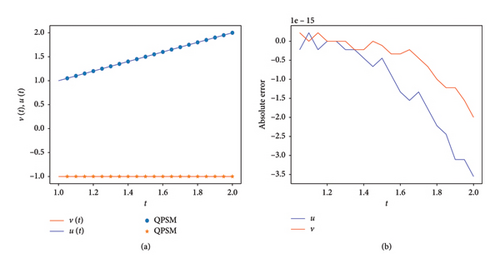

5. Conclusions
One of the main advantages of the QSPM is its applicability to linear and nonlinear ODEs. The QPSM can be implemented on linear ODEs very easily, but nonlinear ODEs are not straightforward. Finding a suitable linearized form of nonlinear ODEs and finding the initial guess are not easy. This article proposes a novel approach based on quantum computing to solve the second Painlevé equation. These models have high nonlinearity. Two approaches are investigated: first, a series solution is obtained, and then the rational solutions. The nonlinear equations are linearized using the successive linearization method. In all examples, the comparisons with numerical and semianalytical methods show the efficiency of the results. The accurate results are obtained by choosing suitable parameter values. Given the capabilities of quantum algorithms, their implementation on fractional differential equations is not out of the question and could yield interesting results in this field in the future.
Conflicts of Interest
The author declares no conflicts of interest.
Funding
No funding was received for this research.
Open Research
Data Availability Statement
The data that support the findings of this study are available from the corresponding author upon reasonable request.



